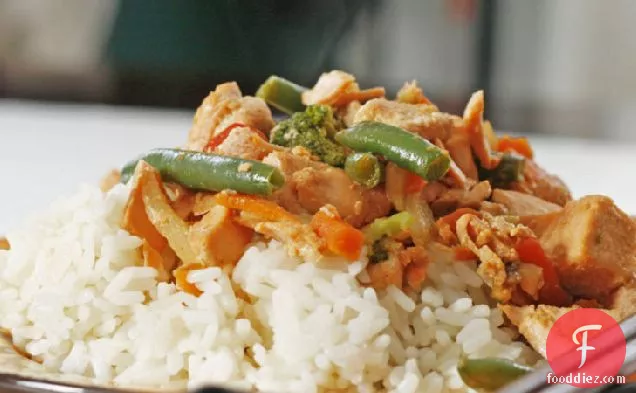Salmon Stir-Fry

Salmon Stir-Fry might be just the main course you are searching for. This gluten free, dairy free, and pescatarian recipe serves 4. One portion of this dish contains approximately 31g of protein, 17g of fat, and a total of 519 calories. From preparation to the plate, this recipe takes around 15 minutes. A mixture of sesame oil, extra virgin olive oil, seasoned rice vinegar, and a handful of other ingredients are all it takes to make this recipe so delicious. To use up the low sodium soy sauce you could follow this main course with the Banana Split Cake as a dessert.
Instructions
1
Cook rice in water as directed on package to make 4 cups cooked rice.
Ingredients you will need![Rice]() Rice
Rice![Water]() Water
Water
2
Meanwhile, heat olive oil and sesame oil in a large skillet over medium heat.
Ingredients you will need![Sesame Oil]() Sesame Oil
Sesame Oil![Olive Oil]() Olive Oil
Olive Oil
Equipment you will use![Frying Pan]() Frying Pan
Frying Pan
3
Add the garlic and ginger to the skillet and heat, stirring constantly, for 1 minute.
Ingredients you will need![Garlic]() Garlic
Garlic![Ginger]() Ginger
Ginger
Equipment you will use![Frying Pan]() Frying Pan
Frying Pan
4
Add the salmon chunks and cook, stirring once for 2 to 3 minutes or until partially opaque. Cover the skillet and cook for another 2 to 3 minutes, until the salmon is opaque and flakes easy with fork.
Ingredients you will need![Salmon]() Salmon
Salmon
Equipment you will use![Frying Pan]() Frying Pan
Frying Pan
5
Remove cover from skillet; stir in the frozen vegetables.
Ingredients you will need![Vegetable]() Vegetable
Vegetable
Equipment you will use![Frying Pan]() Frying Pan
Frying Pan
Equipment
Ingredients
946milliliters![cooked rice]() cooked rice2Tbsps
cooked rice2Tbsps![extra virgin olive oil]() extra virgin olive oil4cloves
extra virgin olive oil4cloves![garlic, minced]() garlic, minced1teaspoon
garlic, minced1teaspoon![ground ginger]() ground ginger59milliliters
ground ginger59milliliters![low-sodium soy sauce (plus extra for drizzling)]() low-sodium soy sauce (plus extra for drizzling)473milliliters
low-sodium soy sauce (plus extra for drizzling)473milliliters![frozen vegetables (recommended: Cascadian Farms Chinese Style Stir-Fry Blend)]() frozen vegetables (recommended: Cascadian Farms Chinese Style Stir-Fry Blend)454grams
frozen vegetables (recommended: Cascadian Farms Chinese Style Stir-Fry Blend)454grams![salmon filets, cut the salmon into 1-inch chunks]() salmon filets, cut the salmon into 1-inch chunks2teaspoons
salmon filets, cut the salmon into 1-inch chunks2teaspoons![seasoned rice vinegar]() seasoned rice vinegar2teaspoons
seasoned rice vinegar2teaspoons![sesame oil]() sesame oil
sesame oil
 cooked rice2Tbsps
cooked rice2Tbsps extra virgin olive oil4cloves
extra virgin olive oil4cloves garlic, minced1teaspoon
garlic, minced1teaspoon ground ginger59milliliters
ground ginger59milliliters low-sodium soy sauce (plus extra for drizzling)473milliliters
low-sodium soy sauce (plus extra for drizzling)473milliliters frozen vegetables (recommended: Cascadian Farms Chinese Style Stir-Fry Blend)454grams
frozen vegetables (recommended: Cascadian Farms Chinese Style Stir-Fry Blend)454grams salmon filets, cut the salmon into 1-inch chunks2teaspoons
salmon filets, cut the salmon into 1-inch chunks2teaspoons seasoned rice vinegar2teaspoons
seasoned rice vinegar2teaspoons sesame oil
sesame oilRecommended wine: Chardonnay, Pinot Noir, Sauvignon Blanc
Salmon can be paired with Chardonnay, Pinot Noir, and Sauvignon Blanc. To decide on white or red, you should consider your seasoning and sauces. Chardonnay is a great friend to buttery, creamy dishes, while sauvignon blanc can complement herb or citrus-centric dishes. A light-bodied, low-tannin red such as the pinot noir goes great with broiled or grilled salmon. You could try Foley Estate Winery Sta. Rita Hills Chardonnay. Reviewers quite like it with a 4.3 out of 5 star rating and a price of about 27 dollars per bottle.

Foley Estate Winery Sta. Rita Hills Chardonnay
Rancho Santa Rosa Vineyard was originally conceived as individual micro-vineyards delineated into 59 unique blocks based upon soil, exposure, elevation, grade, rootstock and clone. Rancho Santa Rosa produces remarkably rich and silky wines.DifficultyNormal
Ready In15 m.
Servings4
Health Score70
Related recipes
Turkey with Country Ham Stuffing
Party Italian Wedding Soup
Turkey Alfredo Tetrazzini
Stuffed Shells with Meat Sauce
Magazine

Your Inner Chef with Taylor Swift's Top 3 Recipes from Her Beloved NYC Hangout

20 Mouthwatering Recipes You Need to Try Today!

Master the Art of Making Perfect Pancakes with This Foolproof Recipe

The Science Behind Red Wine: Its Surprising Health Benefits and Potential Risks

12 Wine Cocktails for a Sophisticated Twist

Sip, Swirl, and Celebrate: Toasting to National Wine Day on May 25th

National Drink Wine Day on February 18

Celebrating Souffle Day with Delectable Delights

Indulge in the Delightful Flavor of Oyster Soup on Its Special Day!

Celebrating World Nutella Day

Your Inner Chef with Taylor Swift's Top 3 Recipes from Her Beloved NYC Hangout

20 Mouthwatering Recipes You Need to Try Today!

Sip, Swirl, and Celebrate: Toasting to National Wine Day on May 25th

National Drink Wine Day on February 18

Indulge in the Delightful Flavor of Oyster Soup on Its Special Day!

These Super Recipes for Your Football Party!

The Secrets Behind 3 Classic Comfort Food Recipes

Recipes to Spice Up Your February Menu

Top 20+ Must-Try Recipes Dominating February 2024











